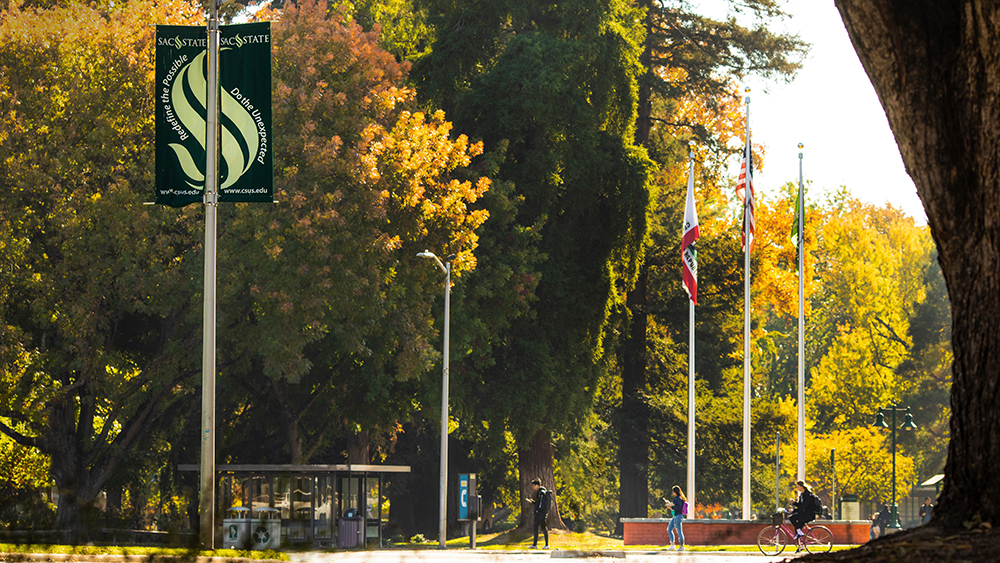 Fall will welcome a new class of incoming Sacramento State students, most of whom will be receiving instruction online. And many are taking advantage of the University's scheduling innovation. (Sacramento State/Andrea Price)
Fall will welcome a new class of incoming Sacramento State students, most of whom will be receiving instruction online. And many are taking advantage of the University's scheduling innovation. (Sacramento State/Andrea Price)
By Cynthia Hubert
Sacramento State’s incoming freshman class for Fall 2020 is unique. It's the first to begin a semester during a public health pandemic, and the first to start classes in a predominantly online learning environment.
The students also represent the first wave of freshmen at the University to register for classes in an innovative way – through strategic scheduling, known at Sac State as Hornet Launch.
Sac State is planning and recommending courses for the Fall 2020 freshman class based on surveys of their education priorities and areas of interest, as well as their responsibilities outside of college. The new approach is helping the new Hornets more easily enroll in classes they want and need.
 James Dragna, executive director of University Initiatives and Student Success, says timing is right for the Hornet Launch scheduling program. (Sacramento State/Andrea Price)
James Dragna, executive director of University Initiatives and Student Success, says timing is right for the Hornet Launch scheduling program. (Sacramento State/Andrea Price)Students seem to be embracing the idea, said the University’s graduation czar, James Dragna, executive director of University Initiatives and Student Success. Most incoming freshmen have completed a Hornet Launch Survey designed to help faculty members structure the most logical schedules for each student.
“Overall, we’re very pleased with how students are responding to a new way of doing things,” Dragna said.
Under Hornet Launch, incoming freshmen no longer build their schedules based primarily on course availability. Instead, they are assigned recommended courses totaling 14 to 16 units to kick off their first semester.
Course assignments are based on student survey results and information from faculty, such as which classes are in greatest demand. Included in the course schedules are “exploratory” classes, similar to electives, which allow students to delve into subjects outside of their majors.
The approach is designed to be less stressful and more efficient, and place students on a trajectory toward graduating in a timely manner.
“They’re getting early advising and counseling, particularly around their majors, and that helps them lay the foundation for the next four years,” Dragna said. “We’re creating sections that are in the most demand so that we can give them the classes that they want and need.”
Hornet Launch helps address bottlenecks that previously prevented students from obtaining classes that are necessary to fulfill their course requirements, he noted. And because lectures will be delivered online, students who miss classes because of work or family responsibilities will be able to view them remotely at their convenience.
“Coincidentally, this turns out to be the right program at exactly the right time,” Dragna said.
Hornet Launch is part of the University’s strategies to boost graduation rates, efforts that had begun to pay off before the coronavirus pandemic took hold. The University’s “Finish in Four” campaign has led to an extraordinary 127 percent gain since 2016 in the number of students completing their course work in four years.
Administrators at Sac State and at colleges across the country were bracing for a significant drop in enrollment this fall because of the effects of the pandemic and the switch to mostly online coursework.
But with fall enrollment nearly complete, Sac State is expecting only a slight dip in admissions compared to last year, said Ed Mills, vice president for Student Affairs. About 3 percent fewer new students are expected to enroll than in 2019.
The number of new transfer students is on pace to significantly rise, but Sac State expects fewer new freshmen, Mills said.
Mills attributes the drop in part to the abrupt switch during the spring to online learning among high school seniors. Many of these students “did not have a good experience” with virtual learning and prefer to postpone entering college until they can take courses face to face, he said.
Unlike Sac State’s faculty and students, most high school teachers and pupils had to pivot to online teaching with little preparation or resources, he said.
“Doing well in an online environment requires good access to technology, reliable high-speed internet access and the ability to find spaces that are conducive to focused concentration,” Mills said. And although Sac State provided many students with laptops and WiFi “hotspots,” among other tools, “many of our incoming first-year students didn’t have those advantages,” he said.
“Given all these factors, the prospect of virtual learning for the fall may not be as attractive for some.”
Sac State faculty are training this summer on techniques for improving delivery of online courses and ensuring that the virtual learning experience is as effective and as satisfying as possible, Mills said. The University also is working to enhance virtual services such as academic advising, tutoring and peer coaching.
“The University is doing all kinds of things to help mitigate the current challenges and create a good experience for our new students,” Mills said.
Hornet Launch is part of that effort, and new freshmen appear to be enthusiastic about it, said Dragna.
To date, more than 3,500 incoming freshmen have completed the Hornet Launch Survey in preparation for their first semester, he said. The number represents more than 75 percent of students who have accepted their admissions.
The participation rate bodes well for their futures, Dragna said.
“It shows us very clearly that this incoming class of students is interested in developing a first-year schedule of courses that fits their current needs and adds to their future academic success,” he said. “Despite everything that’s going on, students are continuing to progress and work toward their goals.”
